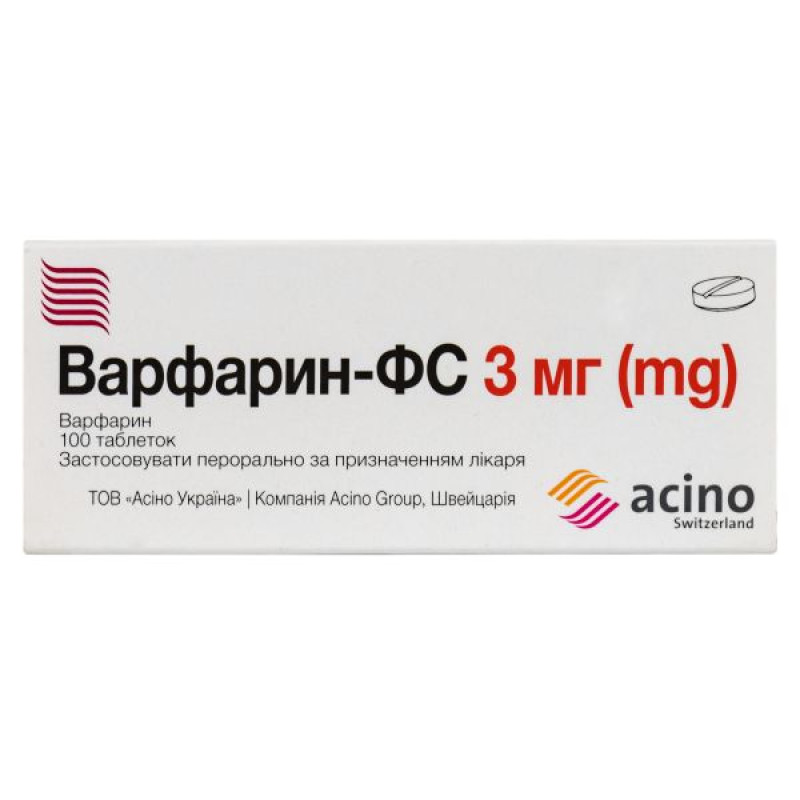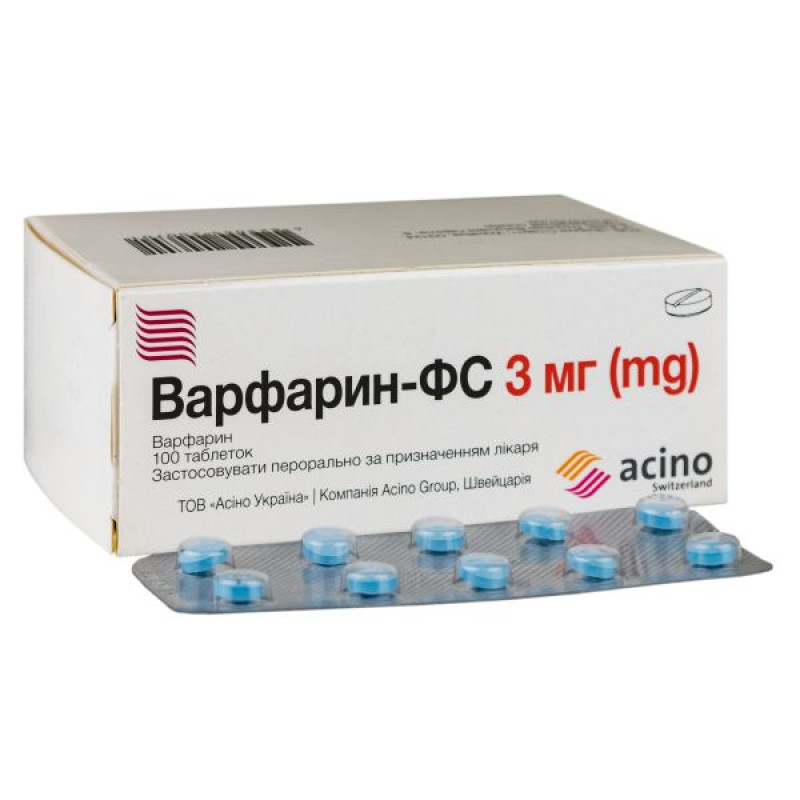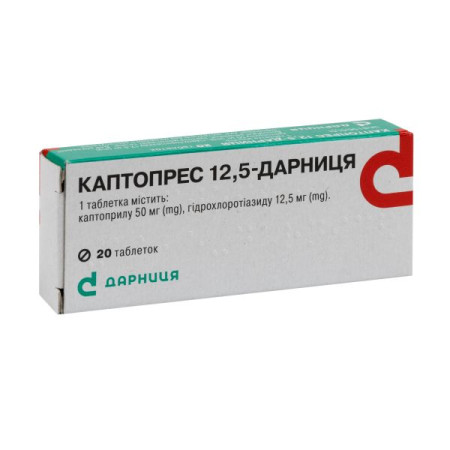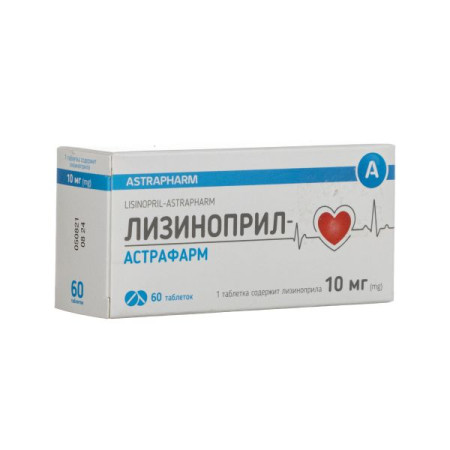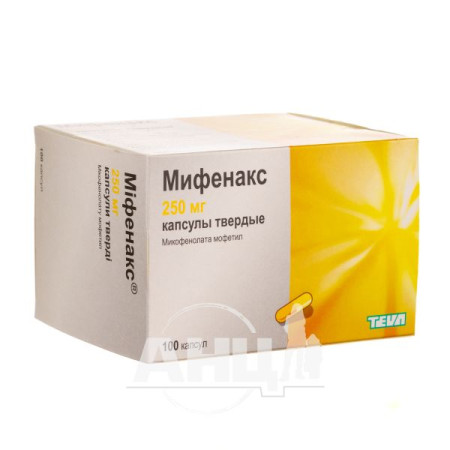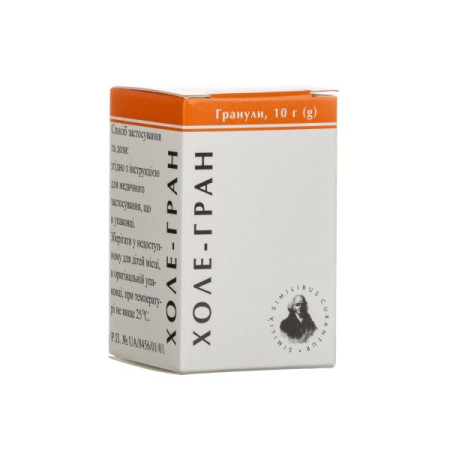Warfarin-FS tablets 3 mg blister No. 100
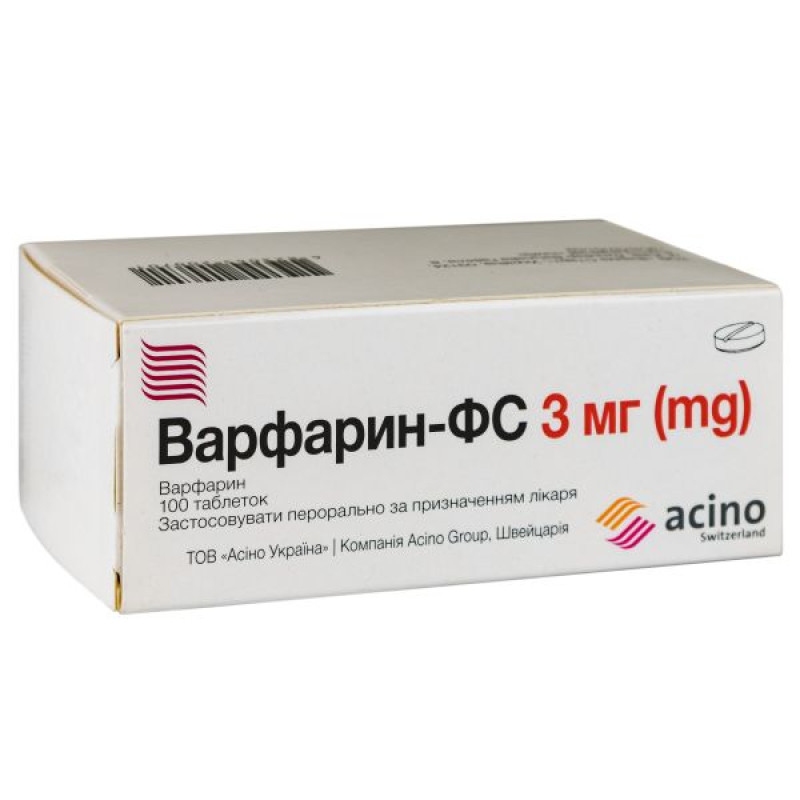
Warfarin-FS tablets are used for the following indications:
prevention and treatment of deep vein thrombosis and pulmonary embolism; secondary prevention of myocardial infarction and prevention of thromboembolic complications (stroke or systemic embolism) after myocardial infarction; prevention of thromboembolic complications in patients with atrial fibrillation, heart valve disease or prosthetic heart valves; prevention of transient ischemic attacks and stroke.Composition
The active substance is warfarin sodium clathrate (one tablet contains warfarin sodium clathrate equivalent to 3 mg of warfarin sodium).
Excipients: lactose monohydrate, corn starch, gelatin, indigo carmine (E 132), magnesium stearate.
Contraindication
Hypersensitivity to warfarin or to any of the components of the drug; clinically established bleeding; bleeding tendency (hemophilia, von Willebrand disease, thrombocytopenia and platelet dysfunction); to avoid the risk of severe bleeding within 72 hours after major surgery, within 48 hours in the postpartum period; severe renal and hepatic insufficiency and cirrhosis of the liver; untreated or uncontrolled arterial hypertension; recent hemorrhagic stroke; health conditions that predispose to intracranial hemorrhage, such as cerebral aneurysm, aortic aneurysm; tendency to fall; lumbar puncture; central nervous system or eye surgery; gastrointestinal or renal bleeding and their complications; diverticulosis; malignant tumors; esophageal varices; endocarditis or pericarditis (including exudative). Conditions in which therapy cannot be safely administered (e.g. psychosis, dementia, alcoholism). The drug is contraindicated in women in the first trimester of pregnancy and during the last four weeks of pregnancy. The drug is contraindicated in patients with an increased risk of bleeding (including patients with hemorrhagic diathesis, esophageal varices, arterial aneurysms, lumbar puncture, gastric ulcer, severe wounds (including surgical), cerebrovascular disorders with a risk of cerebral hemorrhage, bacterial endocarditis and malignant arterial hypertension). Patients receiving warfarin treatment should not use drugs (including herbal preparations) containing hypericum perforatum (St. John's wort), since their joint use causes a decrease in the concentration of warfarin in the blood plasma, which leads to a decrease in the clinical effect.Method of application
The optimal dose of the drug is set individually for each patient, taking into account the state of the blood coagulation system. To standardize the results of prothrombin time determination, it is recommended to use MNI, which takes into account the effect of the thromboplastin used on the value of prothrombin time.
Target INR level for oral anticoagulant therapy
Prevention of thromboembolic complications in patients with prosthetic heart valves: INR 2.5-3.5.
Other indications: INR 2.0-3.0.
Adults
For patients of normal weight and a spontaneous INR below 1.2, administer 10 mg of warfarin for the next three days. Then calculate the dose using the data below according to the INR measurements on the fourth day.
In patients with hereditary protein C or S deficiency, the recommended initial dose is 5 mg of warfarin for the next three days. The dose should then be calculated as follows based on the INR measurements on the fourth day.
Patients with hereditary antithrombotic protein C deficiency are at risk of developing skin necrosis when initiating warfarin therapy. In such cases, the drug should be started without a loading dose of warfarin, even if the patient is receiving heparin.
If skin necrosis develops, warfarin should be discontinued.
For elderly patients, patients with low body weight, with a spontaneous INR above 1.2, or those with concomitant diseases or receiving any medications that affect the effectiveness of anticoagulant therapy, the recommended initial dose is 5 mg of warfarin for the next two days. The dose is then calculated according to the data below according to the INR measurements on the third day.
INR measurements should be performed daily until a stable target level is reached, which is usually set on the 5th-6th day of treatment. INR measurements should then be performed weekly, reaching a 4-week interval. In the case of large deviations in INR levels or in patients with liver disease or diseases that affect the absorption of vitamin K, measurement intervals may be less than 4 weeks. The appointment of new or cancellation of previously taken drugs requires additional INR measurements. With long-term therapy, adjustment is made to the weekly dose of warfarin in accordance with the above data. If the dose requires adjustment, the next INR measurement should be performed one or two weeks after the adjustment. After this, measurements are continued until 4-week intervals are reached.
Children
Anticoagulant therapy in children is carried out under the supervision of a pediatrician. Doses are selected according to the data below.
Recommended dosage:
day 1 - if the baseline INR value is from 1.0 to 1.3, the initial dose is 0.2 mg/kg body weight (0.1 mg/kg body weight in case of impaired liver function); days 2 to 4, if the INR value (maintenance dose): from 1.1 to 1.3 - repeat the initial dose; from 1.4 to 1.9 - 50% of the initial dose; from 2.0 to 3.0 - 50% of the initial dose; from 3.1 to 3.5 - 25% of the initial dose; > 3.5 - stop taking the drug until the INR reaches <3.5, then - resume treatment with a dose that is 50% of the previous dose; maintenance therapy, if the INR value (weekly dose): from 1.1 to 1.4 - increase the dose by 20%; from 1.5 to 1.9 - increase the dose by 10%; from 2.0 to 3.0 - no change; from 3.1 to 3.5 - reduce the dose by 10%; > 3.5 - stop taking the drug until the INR reaches <3.5, then - resume treatment with a dose 20% less than the previous one.Planned operations
Pre-, intra-, and postoperative anticoagulant therapy should be administered as indicated below.
Determine the MNI one week before the scheduled surgery.
Stop warfarin 1-5 days before surgery. In case of high risk of thrombosis, the patient should be given low molecular weight heparin subcutaneously for prophylaxis. The duration of the warfarin break depends on the INR. Stop warfarin:
5 days before surgery if INI> 4.0; 3 days before surgery if INI from 3.0 to 4.0; 2 days before surgery if INI from 2.0 to 3.0.Determine the INR the evening before surgery and administer 0.5-1.0 mg of vitamin K orally or intravenously if the INR is > 1.8.
Consider the need for infusion of unfractionated heparin or prophylactic administration of low molecular weight heparin on the day of surgery.
Continue subcutaneous administration of low molecular weight heparin for 5-7 days after surgery with concomitant resumption of warfarin.
Continue warfarin at the usual maintenance dose on the same day in the evening after minor surgery and in the afternoon when the patient begins receiving enteral nutrition after major surgery.
Application features
Pregnant women
When used during pregnancy, warfarin can cause birth defects and fetal death. Women of childbearing age should use effective contraception during treatment. Warfarin crosses the placenta. Antithrombotic therapy during pregnancy should be carried out individually under the supervision of appropriate specialists.
Warfarin can be used during breastfeeding. Warfarin is excreted in breast milk, but if the drug is taken in therapeutic doses, then adverse reactions in the newborn are not expected.
Drivers
The drug does not affect the ability to drive or operate complex mechanisms.
Overdose
An elevated INR is an indicator of warfarin overdose, which increases the risk of bleeding. A halving of coagulation factor IV indicates an elevated INR. An elevated INR occurs within 24 hours and reaches a maximum value within 36-72 hours after taking the drug.
Clinical manifestations begin to appear a few days or weeks after taking the drug and are characterized by nosebleeds, bleeding gums, pallor, hematomas around the joints and buttocks, the presence of blood in the urine and feces. Other symptoms may include back pain, bleeding lips, bleeding mucous membranes, abdominal pain, vomiting and petechiae.
Central paralysis due to bleeding, profuse bleeding, and death may occur in the future.
Treatment: Symptomatic and supportive therapy in case of overdose.
Side effects
The most common adverse reactions of warfarin are hemorrhages and bleeding, including: nosebleeds, hemoptysis, hematuria, bleeding gums, bruising, vaginal bleeding, conjunctival hemorrhage, gastrointestinal bleeding, prolonged and profuse bleeding after surgery and after trauma. Bleeding can be serious and lead to death, hospitalization, and blood transfusion in patients who have been on long-term anticoagulant treatment.
Storage conditions
Store in the original packaging at a temperature not exceeding 25 °C, out of the reach of children.
Shelf life - 3 years.
There are no reviews for this product.
There are no reviews for this product, be the first to leave your review.
No questions about this product, be the first and ask your question.







